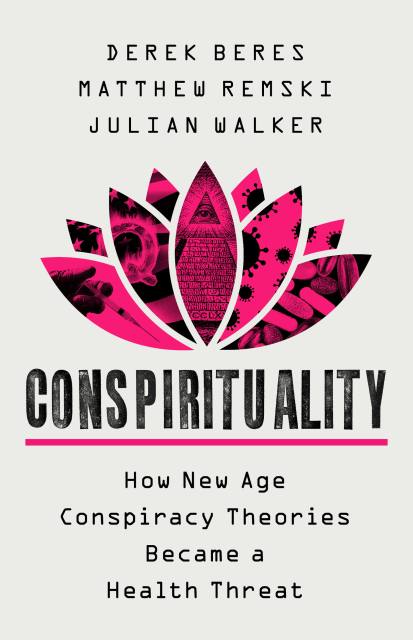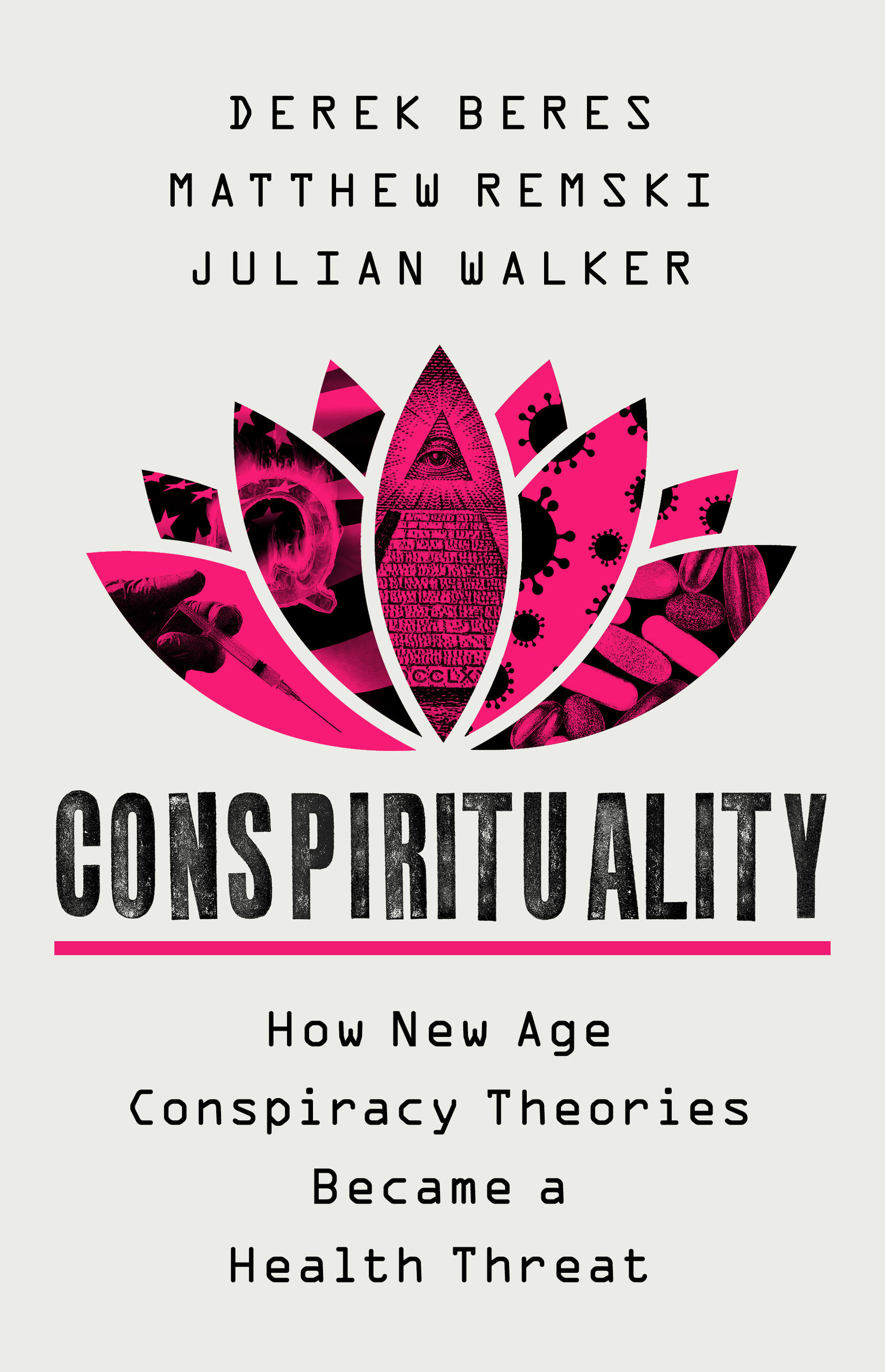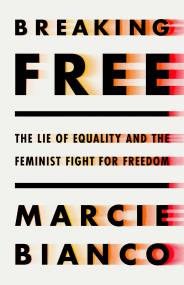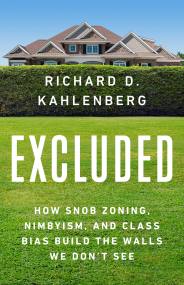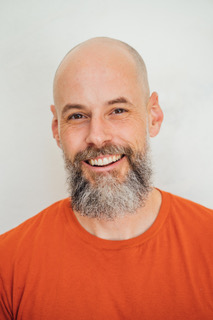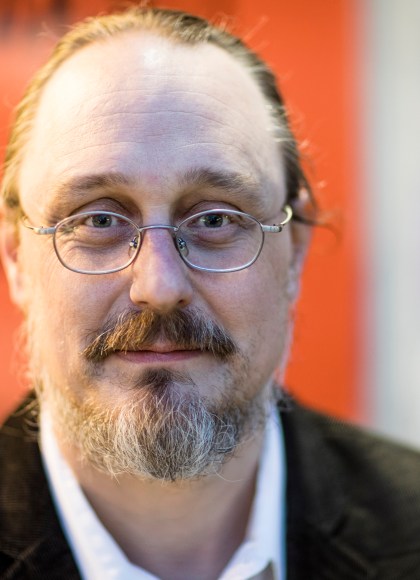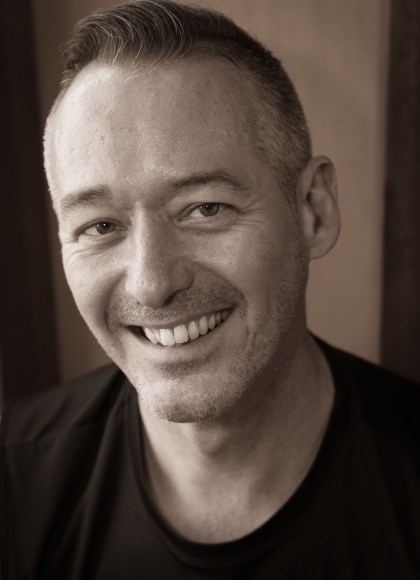Promotion
Use code FALL24 for 20% off sitewide!
Conspirituality
How New Age Conspiracy Theories Became a Health Threat
Contributors
By Derek Beres
Formats and Prices
Price
$30.00Format
Format:
- Hardcover $30.00
- ebook $18.99
- Audiobook Download (Unabridged) $31.99
This item is a preorder. Your payment method will be charged immediately, and the product is expected to ship on or around June 13, 2023. This date is subject to change due to shipping delays beyond our control.
Also available from:
In the early days of the COVID-19 pandemic, a disturbing social media trend emerged: a large number of yoga instructors and alt-health influencers were posting stories about a secretive global cabal bent on controlling the world’s population with a genocidal vaccine. Instagram feeds that had been serving up green smoothie recipes and Mary Oliver poems became firehoses of Fox News links, memes from 4chan, and prophecies of global transformation.
Since May 2020, Derek Beres, Matthew Remski and Julian Walker have used their Conspirituality podcast to expose countless facets of the intersection of alt-health practitioners with far-right conspiracy trolls. Now this expansive and revelatory book unpacks the follies, frauds, cons and cults that dominate the New Age and wellness spheres and betray the trust of people who seek genuine relief in this uncertain age.
With analytical rigor and irreverent humor, Conspirituality offers an antidote to our times, helping readers recognize wellness grifts, engage with loved ones who've fallen under the influence, and counter lies and distortions with insight and empathy.
-
“Packed with surprising insights and no-holds-barred takedowns, this is a forceful exposé.”Publishers Weekly
-
“No one knows the explosive intersection of spirituality and extremism better than the authors of Conspirituality, who have been inside these groups and lived to tell about it. In their strongly argued new book, the authors look at the charlatans, conspiracy theorists, and con men of the wellness world—and what we can do to stop them.”Will Sommer, author of Trust the Plan
-
“Conspirituality brilliantly exposes the fusion between conspiracy theories and wellness while emphasizing the ‘con’ aspect at the heart of both. Truly, there are grifters and scammers everywhere in this world, and the authors have their number, revealing their psychological tricks and how they exploit the pain and trauma of their marks. And far from seeing themselves as too smart to fall for this nonsense, the authors mine their own experiences in cults and coercive movements having seen them from the inside.”Mike Rothschild, author of The Storm is Upon Us and Jewish Space Lasers
-
“Intelligent and compassionate, Conspirituality is full of insight rooted in direct experience and rigorous analysis. The authors are deeply familiar with and curious about their subject. An essential and unique book that captures both the yearning for and devastating effects of conspirituality as a phenomenon and way of life.”Julian Feeld, cohost of the QAnon Anonymous podcast
-
“A thoughtful, deeply empathetic exploration of an often-disturbing convergence. As fear, paranoia, and suspicion continue to seep into the New Age health and wellness worlds, Remski, Beres and Walker are uniquely well-positioned to be our guides into the ‘sparkling but flimsy’ answers that conspirituality represents.”Anna Merlan, author of Republic of Lies
-
“A fascinating, straightforward, well-researched, and sobering unpacking of the complex history, and present-day phenomena, of distorted beliefs within New Age yoga and wellness spaces.”Seane Corn, yoga teacher and author of Revolution of the Soul
-
“A wild and impassioned ride through the recent history of the wellness-based conspiracy movement, some of its most unsavory characters, and many of its victims and survivors. Full of heart, honesty, and immediacy.”Dr. Theodora Wildcroft, author of Post-Lineage Yoga
-
“This is a book for right now! So timely. So needed. Conspirituality takes us on a fascinating, engaging, and empathetic journey through the many ways in which harmful pseudoscience and misinformation has seeped into our world—including into a host of unexpected places like alternative schools and, yep, yoga studios. The authors provide a compelling argument as to why the toleration of conspiratorial rhetoric closes minds and erodes critical thinking. I highly recommend this book to anyone who is curious—and we all should be!—about the history and the social and cultural forces behind our current pseudoscience-filled mess.”Timothy Caulfield, author of Relax
-
“This rigorously researched book will help future generations, or alien overlords, make sense of this bizarre and confusing moment in human civilization. Beres, Remski, and Walker have established themselves as authoritative chroniclers of conspirituality and its key figures. They are consummate tour guides, revealing all the threads of eugenics, fascism, cultism, moral panic, and magical thinking that came together to form a strange tapestry that now influences mainstream policies and institutions and fuels our culture wars.”Jennings Brown, journalist and host of The Gateway and Revelations podcasts
-
“An urgently needed, compelling, and accessible analysis of the deeply troubling proliferation and promotion of conspiracy theories within contemporary spirituality and wellness culture. Combining cutting-edge critique with empathetic context, the authors identify the real threats of conspirituality to societal bonds, public health, and participatory democracy.”Ann Gleig, associate professor of religion and cultural studies, University of Central Florida
-
“This is a groundbreaking and beautifully written roadmap into a topic that is so multifaceted, internally diverse, and consequential I would not have trusted anyone to write it except these authors. The book benefits from their years of immersive experience and deep research on conspirtitualist milieus. A masterful job.”Amarnath Amarasingam, School of Religion, Queen’s University, Ontario
-
“An eye-opening dissection of the historical roots that gave life to this modern hybrid of grand conspiracism and spirituality, accompanied by lyrical portraits of this mad, mongrel philosophy’s biggest influencers, Conspirituality makes sense of humanity’s latest brain fart with compassion and exhaustive scholarship. Beres, Remski, and Walker have earned the mantle of torchbearers against conspirituality, illuminating the disturbing crevices of this befuddling movement and helping the rest of us understand, through impeccable prose, what is fueling the world’s strangest fever dream.”Jonathan Jarry, MSc, science communicator, Office for Science and Society, McGill University
-
“Over the last several years as we doom-scrolled social media, watching the weird unraveling of the wellness community into a conspiratorial freak-out, the Conspirituality podcast’s deep-dive analysis was a salve. In their book, they go a step further, providing important context and histories, positing maybe the great awakening was realizing these beliefs were lurking beneath the surface all along.”Stacie Stukin, journalist
-
“The space of conspirituality in recent years has become an intricate and confusing web that stretches from crystal healers and vegan yoga practitioners to QAnon influencers and Silicon Valley entrepreneurs. With this book, the authors combine their years of experience and research to provide a detailed analytical map of this influential contemporary phenomenon. It is rigorously researched, deeply empathetic, and at times intensely personal.”Chris Kavanagh, associate professor of psychology, Rikkyo University
-
“Conspirituality is full of personal stories, deep dives into the history of naturalist conspiracism, and an analysis of how conspirituality is shaping our modern world. It balances the need for understanding and compassion toward victims of these cult mentalities with concern for the harms of conspirituality and the need to stem its growth.”Aaron Rabinowitz, PhD candidate, Rutgers Graduate School of Education, and host of the Embrace the Void podcast
-
“Beres, Remski, and Walker manage something remarkable: with erudition and a wealth of experience, they expose treachery and danger hiding in places few expect it. And yet Conspirituality is as noteworthy for its captivating storytelling and whit. The result is a book that feels like both a responsibility and a pleasure to read.”Benjamin R. Teitelbaum, author of War for Eternity
-
“[Conspirituality] provides a deeper understanding to why some of your friends from the CrossFit box took an early January field trip to the Capitol, or why your yoga studio may have suddenly became fixated on Dr. Fauci. It's also a sympathetic attempt to explain why conspiratorial thinking about health and wellness is so appealing to so many people. It also provides some needed historical context of the underlying movements that gave us some of the influencers who rose to prominence during the pandemic.”GQ
- On Sale
- Jun 13, 2023
- Page Count
- 384 pages
- Publisher
- PublicAffairs
- ISBN-13
- 9781541702981
Praise
-
“Packed with surprising insights and no-holds-barred takedowns, this is a forceful exposé.”Publishers Weekly
-
“No one knows the explosive intersection of spirituality and extremism better than the authors of Conspirituality, who have been inside these groups and lived to tell about it. In their strongly argued new book, the authors look at the charlatans, conspiracy theorists, and con men of the wellness world—and what we can do to stop them.”Will Sommer, author of Trust the Plan
-
“Conspirituality brilliantly exposes the fusion between conspiracy theories and wellness while emphasizing the ‘con’ aspect at the heart of both. Truly, there are grifters and scammers everywhere in this world, and the authors have their number, revealing their psychological tricks and how they exploit the pain and trauma of their marks. And far from seeing themselves as too smart to fall for this nonsense, the authors mine their own experiences in cults and coercive movements having seen them from the inside.”Mike Rothschild, author of The Storm is Upon Us and Jewish Space Lasers
-
“Intelligent and compassionate, Conspirituality is full of insight rooted in direct experience and rigorous analysis. The authors are deeply familiar with and curious about their subject. An essential and unique book that captures both the yearning for and devastating effects of conspirituality as a phenomenon and way of life.”Julian Feeld, cohost of the QAnon Anonymous podcast
-
“A thoughtful, deeply empathetic exploration of an often-disturbing convergence. As fear, paranoia, and suspicion continue to seep into the New Age health and wellness worlds, Remski, Beres and Walker are uniquely well-positioned to be our guides into the ‘sparkling but flimsy’ answers that conspirituality represents.”Anna Merlan, author of Republic of Lies
-
“A fascinating, straightforward, well-researched, and sobering unpacking of the complex history, and present-day phenomena, of distorted beliefs within New Age yoga and wellness spaces.”Seane Corn, yoga teacher and author of Revolution of the Soul
-
“A wild and impassioned ride through the recent history of the wellness-based conspiracy movement, some of its most unsavory characters, and many of its victims and survivors. Full of heart, honesty, and immediacy.”Dr. Theodora Wildcroft, author of Post-Lineage Yoga
-
“This is a book for right now! So timely. So needed. Conspirituality takes us on a fascinating, engaging, and empathetic journey through the many ways in which harmful pseudoscience and misinformation has seeped into our world—including into a host of unexpected places like alternative schools and, yep, yoga studios. The authors provide a compelling argument as to why the toleration of conspiratorial rhetoric closes minds and erodes critical thinking. I highly recommend this book to anyone who is curious—and we all should be!—about the history and the social and cultural forces behind our current pseudoscience-filled mess.”Timothy Caulfield, author of Relax
-
“This rigorously researched book will help future generations, or alien overlords, make sense of this bizarre and confusing moment in human civilization. Beres, Remski, and Walker have established themselves as authoritative chroniclers of conspirituality and its key figures. They are consummate tour guides, revealing all the threads of eugenics, fascism, cultism, moral panic, and magical thinking that came together to form a strange tapestry that now influences mainstream policies and institutions and fuels our culture wars.”Jennings Brown, journalist and host of The Gateway and Revelations podcasts
-
“An urgently needed, compelling, and accessible analysis of the deeply troubling proliferation and promotion of conspiracy theories within contemporary spirituality and wellness culture. Combining cutting-edge critique with empathetic context, the authors identify the real threats of conspirituality to societal bonds, public health, and participatory democracy.”Ann Gleig, associate professor of religion and cultural studies, University of Central Florida
-
“This is a groundbreaking and beautifully written roadmap into a topic that is so multifaceted, internally diverse, and consequential I would not have trusted anyone to write it except these authors. The book benefits from their years of immersive experience and deep research on conspirtitualist milieus. A masterful job.”Amarnath Amarasingam, School of Religion, Queen’s University, Ontario
-
“An eye-opening dissection of the historical roots that gave life to this modern hybrid of grand conspiracism and spirituality, accompanied by lyrical portraits of this mad, mongrel philosophy’s biggest influencers, Conspirituality makes sense of humanity’s latest brain fart with compassion and exhaustive scholarship. Beres, Remski, and Walker have earned the mantle of torchbearers against conspirituality, illuminating the disturbing crevices of this befuddling movement and helping the rest of us understand, through impeccable prose, what is fueling the world’s strangest fever dream.”Jonathan Jarry, MSc, science communicator, Office for Science and Society, McGill University
-
“Over the last several years as we doom-scrolled social media, watching the weird unraveling of the wellness community into a conspiratorial freak-out, the Conspirituality podcast’s deep-dive analysis was a salve. In their book, they go a step further, providing important context and histories, positing maybe the great awakening was realizing these beliefs were lurking beneath the surface all along.”Stacie Stukin, journalist
-
“The space of conspirituality in recent years has become an intricate and confusing web that stretches from crystal healers and vegan yoga practitioners to QAnon influencers and Silicon Valley entrepreneurs. With this book, the authors combine their years of experience and research to provide a detailed analytical map of this influential contemporary phenomenon. It is rigorously researched, deeply empathetic, and at times intensely personal.”Chris Kavanagh, associate professor of psychology, Rikkyo University
-
“Conspirituality is full of personal stories, deep dives into the history of naturalist conspiracism, and an analysis of how conspirituality is shaping our modern world. It balances the need for understanding and compassion toward victims of these cult mentalities with concern for the harms of conspirituality and the need to stem its growth.”Aaron Rabinowitz, PhD candidate, Rutgers Graduate School of Education, and host of the Embrace the Void podcast
-
“Beres, Remski, and Walker manage something remarkable: with erudition and a wealth of experience, they expose treachery and danger hiding in places few expect it. And yet Conspirituality is as noteworthy for its captivating storytelling and whit. The result is a book that feels like both a responsibility and a pleasure to read.”Benjamin R. Teitelbaum, author of War for Eternity
-
“[Conspirituality] provides a deeper understanding to why some of your friends from the CrossFit box took an early January field trip to the Capitol, or why your yoga studio may have suddenly became fixated on Dr. Fauci. It's also a sympathetic attempt to explain why conspiratorial thinking about health and wellness is so appealing to so many people. It also provides some needed historical context of the underlying movements that gave us some of the influencers who rose to prominence during the pandemic.”GQ
